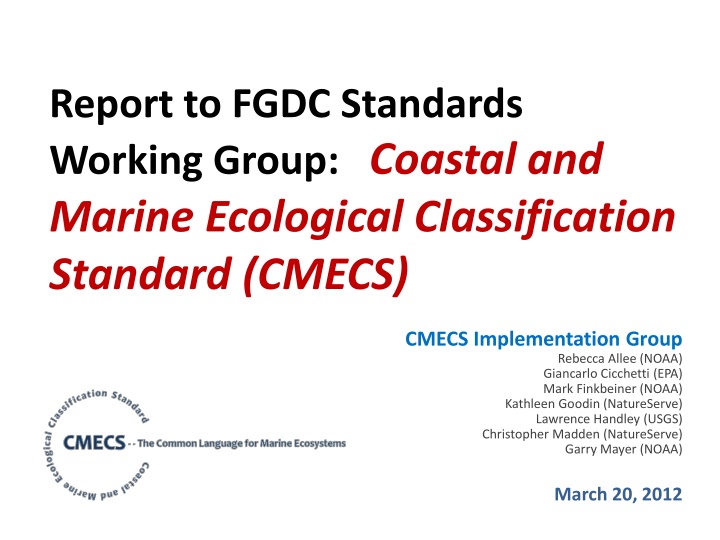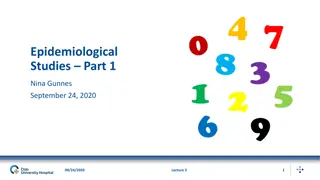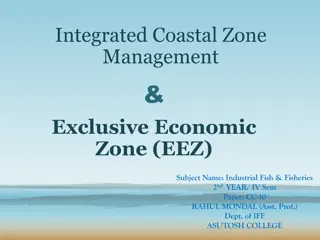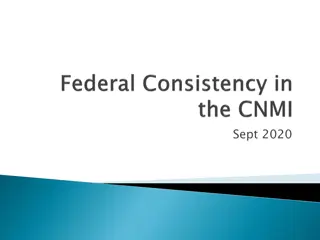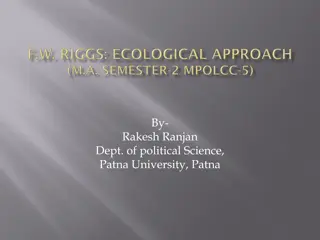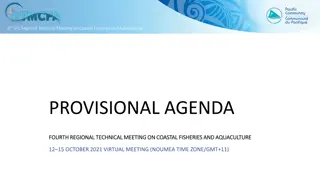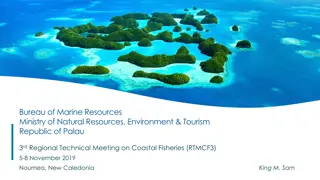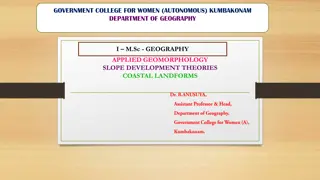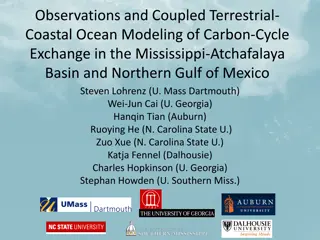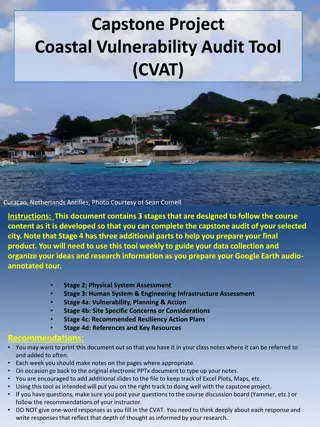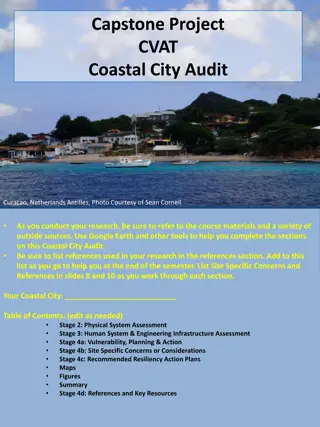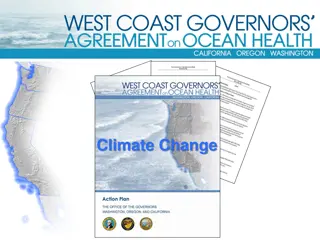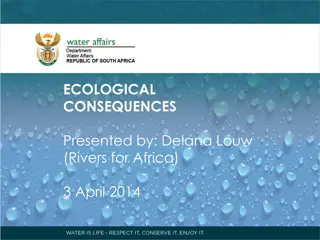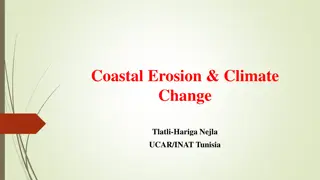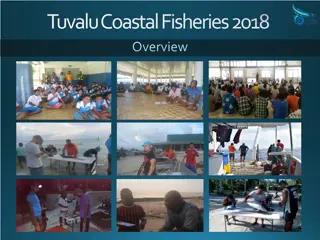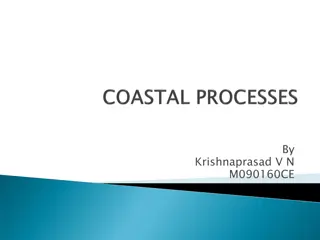Coastal and Marine Ecological Classification Standard (CMECS) Implementation Progress
The report highlights the development, timeline, objectives, and importance of the Coastal and Marine Ecological Classification Standard (CMECS) along with its implementation progress. It discusses the need for a national standard for classifying coastal and marine habitats, the objectives of CMECS, and its scope covering all waters, substrates, and organisms of the marine realm. The report also emphasizes the role of CMECS in enhancing place-based management, tracking changing ecosystems, and promoting data sharing for multiple purposes.
Download Presentation

Please find below an Image/Link to download the presentation.
The content on the website is provided AS IS for your information and personal use only. It may not be sold, licensed, or shared on other websites without obtaining consent from the author.If you encounter any issues during the download, it is possible that the publisher has removed the file from their server.
You are allowed to download the files provided on this website for personal or commercial use, subject to the condition that they are used lawfully. All files are the property of their respective owners.
The content on the website is provided AS IS for your information and personal use only. It may not be sold, licensed, or shared on other websites without obtaining consent from the author.
E N D
Presentation Transcript
Report to FGDC Standards Working Group: Coastal and Marine Ecological Classification Standard (CMECS) CMECS Implementation Group Rebecca Allee (NOAA) Giancarlo Cicchetti (EPA) Mark Finkbeiner (NOAA) Kathleen Goodin (NatureServe) Lawrence Handley (USGS) Christopher Madden (NatureServe) Garry Mayer (NOAA) March 20, 2012
Agenda Background Timeline Purpose Structure Relation to other standards Standard Development Who How Public review Comments received Revisions Resulting document Subsequent steps Summary 2
Timeline 1998: Development initiated 1998-2007: Creation of preliminary versions of standard February 2008: CMECS proposal sponsored by Marine and Spatial Data Subcommittee April 2010: CMECS working draft (version 3.1) submitted for review July 2010: CMECS working draft approved for public review August-December 2010: 120-day public comment period 2011-2012: Standard revised; responses generated January 2012: Revised standard (CMECS version 4.0) submitted to FGDC for endorsement review 3
Objectives Assure consistent names and descriptions of ecological features Accommodate biological, geological, chemical, and physical data in single structure Articulate with FGDC standards and other accepted approaches Be sensor- and scale-neutral Be suitable for multiple applications 4
Why Needed? Enhanced interest in place-based management Greater need to track changing ecosystems More and better mapping Map once, use many times -- Increased data sharing and use of information for multiple purposes No national standard for classifying coastal and marine habitats 5
What is CMECS? CMECS is a catalog of terms Provides means for classifying ecological units in simple, standard format using common terminology Tool for organizing observational information CMECS is not: Mapping guidance Analytical approach for comparing ecosystem units Ecological units classified using CMECS can be mapped, compared, or otherwise analyzed with existing, available methods 6
Scope All waters, substrates, and organisms of the marine realm extending: Landward to tidal splash zone of coasts, intertidal euhaline and brackish wetlands, and waters of Great Lakes Up river/estuary to head of tide, where tide > 0.2 ft (0.06 m) for at least part of month Seaward to deep ocean, including all continental and oceanic waters and Bottom areas 7
Settings and Components Water Column Component (WC) Biogeographic Setting Biotic Component (BC) Substrate Component (SC) Geoform Component (GC) Aquatic Setting 8
Components Structure and features of water column Water Column Component (WC) Assemblages of benthic and suspended/floating organisms Biotic Component (BC) Character and composition of surface and near-surface substrates Substrate Component (SC) Geomorphic and structural character of coast or seafloor Geoform Component (GC) 9
Users Observational, experimental, and analytical scientists from all marine disciplines e.g., biologists, geologists, chemists, oceanographers, modelers, mappers and GIS specialists Governmental agencies at all levels, NGOs, academicians, and industry Coastal and marine planners; resource managers; economists; engineers and developers; military, enforcement, and homeland security personnel 10
Sample Applications Ocean exploration and mapping (including IOCM) Climate change assessment, prediction and planning Coastal and offshore facility placement Natural resource management Coastal and ocean conservation Environmental monitoring Coastal hazard and spill response 11
Development Approach Reach out widely to user communities and potential stakeholders Involve the experts Include not impose Pilot and demonstrate Revise in response Publicize results 12
Cooperators Federal agencies: NOAA, EPA, USGS, FWS, NPS, BOEM, COE, USDA/NRCS, NASA State agencies: MA Division of Marine Fisheries, OR Coastal Management Program, SC Department of Natural Resources, TX Parks and Wildlife, CA State Coastal Conservancy Academia: URI, WHOI, VIMS, U. Miami, U. San Francisco, U. So. Mississippi, FIU, U. Aukland NGOs:NatureServe, TNC International:Australia,Canada, Germany, OAS 13
Leadership and Expertise Implementation Group 8 scientists and managers Turned the crank Dealt with operations and day-to-day issues Working Group Standing panel of 35-40 users and technical experts Responsible for technical content Chosen for discipline expertise, geographic diversity, and stakeholder affiliation Issue Teams Ad hoc groups of selected discipline experts (4-20 people) WG members + invited outside experts Resolved specific issues 14
Relationship to Other Standards Articulates with relevant FGDC standards FGDC 1996 -- Classification of Wetlands and Deepwater Habitats of the United States FGDC 2001 -- Metadata Profile for Shoreline Data FGDC 2008 -- National Vegetation Classification Standard FGDC 1997 -- Soil Geographic Data Standard Articulates with other approaches Wherever possible, built on accepted approaches Crosswalks and comparisons Pilot applications: 12 projects completed; 10 projects underway 15
Public Comments and Peer Reviews August 16 - December 13, 2010 Strong response: ~800 comments from >31 organizations/individuals Sources: on-line form, hard-copy, email, separate write-ups, and edited digital documents 16
Issues Raised Major themes included: Structure/hierarchy Content Definitions Scale Mixes/unit thresholds Implementation 17
Process for Comment Response Comments numbered to allow tracking Comments characterized as general, editorial, or technical Characterized comments organized by document section, CMECS component, agency, topic area, and keywords Comments parsed out to experts and chapter leads Master spreadsheet employed to track and compile responses Original comment documents preserved for context Follow-up briefings arranged for agencies that provided important input
Interactive Response Generation For technical issues, we rarely just returned to our desks to develop replies Reached out to non-CMECS experts Vetted responses with WG members and other professional colleagues Occasionally conferred with commenters if issues complex or unclear In a few cases, convened Issue Teams 19
Quality Control Extramural editor employed to check writing, formatting, and mechanics of document Multiple internal rounds of revision and review January 2012 post-New Year s 4- day session Final document grooming Refining replies on responses CMECS 4.0 much-improved document 20
Major Revisions Significantly refined settings and components Expanded modifiers section Added biotopes chapter Augmented review of spatio-temporal framework Upgraded discussion of data collection and mapping Improved crosswalking guidance
Settings Version 3.1 Version 4.0 Aquatic setting Primarily unchanged Biogeographic setting Hierarchical Realms Provinces Ecoregions New
Components Version 4.0 Version 3.1 Water Column Water Column Reorganized Benthic Biotic Surface Geology Sub-Benthic Biotic Renamed and expanded Substrate Renamed and expanded Removed Geoform Reorganized GeoForm
Biotopes A biotope is defined as the combination of abiotic features and associated species (Connor et al., 2003). Using CMECS, biotopes can be derived by identifying repeating BC biotic communities that are consistently associated with combinations of environmental units . [CMECS ver. 4.0] Water Column Component (WC) Biotic Component (BC) Substrate Component (SC) BIOTOPE 25
CMECS 4.0--Measuring Up Significant product Responsive to reviews and suggestions More straightforward Easier to understand and apply More comprehensive Geographically Ecologically Enhanced guidance and explanations Dynamic standard
Next Steps Assembling infrastructure to maintain and enhance CMECS over time Engaging North American constituents to widen awareness about and use of CMECS Developing specialized implementation guidance Establishing dynamic standard provisions Reaching out internationally 27
CMECS Is a Vital Tool for Marine and Coastal Science and Management Continuity from uplands to sea floor Built on existing classification approaches Common terminology for data from different sources Across methods Across scales Across geographic regions Easily customizable Responsive but stable 28
Thank you! Questions? Comments? 29
Biotic Component Describes composition of biota Benthos Water column Hierarchical Classes and subclasses emulate FGDC Wetland Standard Vegetated assemblage names from FGDC National Vegetation Classification Standard
Substrate Component Characteristics of substrate Particle size and composition To extent of penetration by multicellular biota Substrates: Geologic, biogenic, anthropogenic Particle sizes: Wentworth (1922), mixes: Folk (1954) Hierarchical Substrate origin: Geologic Substrate Class: Unconsolidated Substrate Substrate Subclass: Fine Unconsolidated Substrate Substrate Group : Sandy Mud Substrate Subgroup: Sandy Clay
Geoform Component Major geomorphic or structural characteristics From Greene et al. (2007) with modifications Geologic, biogenic, anthropogenic features Spatially hierarchical, three subcomponents Tectonic Setting: Global tectonic features, scale: >1000 km2 (e.g., abyssal plain) Physiographic Setting: Landscape level geomorphological features, scale: ~100 s km2 (e.g., fjord, submarine canyon) Geoform: Coastal and seafloor structures, scale: <100 km2 (e.g., terminal moraine)
Water Column Component Water column structure and features Four elements; non-hierarchical Vertical layers Temperature and salinity Hydroforms--e.g., gyres, named water masses Biogeochemical features--e.g., oxygen minimum, chlorophyll maximum layers
Biogeographic Setting Reflects composition and characteristics of biological communities Estuarine and marine coastal and shelf environments Marine Ecoregions of the World, Spalding et al. (2007) Marine oceanic Global Open Oceans and Deep Seabed Biogeographic Classification, UNESCO (2009) Both hierarchical Realms Provinces Ecoregions 35
Modifiers Consistent set of variables to further describe standard units Allows users to customize applications Examples: Energy level Percent cover Bottom slope Turbidity 36
Seagrass Bed Classification System, Subsystem, Tidal Zone Marine Nearshore Subtidal Biotic Component (BC) Class: Aquatic Vegetation Bed Subclass: Saltwater Aquatic Rooted Vegetation Biotic Group: Seagrass Bed Biotope: Thalassia testudinum Herbaceous Vegetation Modifier: Dense Substrate Component (SC) Class: Unconsolidated Substrate Subclass: Fine Unconsolidated Substrate Group: Sand Geoform Component (GC) Physiographic Setting: Coast Geoform: Lagoon Water Column Component (WC): Ecoregional Component (EC): Not used Not used Image: C. Moses 37
Sediments and Soils FGDC Soil Geographic Data Standard originally included as part of CMECS 3.1 Significant consternation voiced by public Switched to more commonly used marine sediment classifications--particle sizes: Wentworth (1922); mixes: Folk (1954) Text referencing soil standard developed by soils scientists working in coastal settings 38
Added Soils Text CMECS adopted Folk (1954) due to the clear present-day preferences for it among public and invited reviewers of CMECS, its long-standing historical use in marine work, and its straight- forward approach to classification. In addition to Folk (1954), however, two existing FGDC classifications for substrate mixtures were considered for applications in CMECS. Of these, the Classification of Wetlands and Deepwater Habitats in the United States, FGDC-STD-004 (FGDC 1996b) addresses mostly aquatic substrate as sediment, and provides a fairly coarse method of classification into six major geology-based units. In contrast, the Soil Geographic Data Standard, FGDC-STD-006 (FGDC 1997) and Keys to Soil Taxonomy (Soil Survey Staff 2010) together provide more detailed classification options for classifying soils with many hundreds of descriptors that have been used in soil science for decades. A soils approach specifically recognizes and describes the biological, physical, and chemical processes that form (and alter) the substrate as part of classification. Through the National Cooperative Soil Survey, soil maps are available for all intertidal and supratidal areas of the United States. Users should consider these sources and approaches when classifying substrate in these areas. Although soils approaches have in the past been used mostly for terrestrial work, some coastal scientists (and the USDA Natural Resources Conservation Service) are now applying soil taxonomies to shallow subtidal environments with good results (see Demas et al 1996; Bradley and Stolt 2006; Stolt et al. 2011). Practitioners interested in soils approaches to classifying shallow subtidal (Estuarine Coastal Subsystem) substrate should consult Keys to Soil Taxonomy (Soil Survey Staff 2010), and Schoeneberger et al. (2002). It is recommended that a soils approach be used if a more detailed classification is needed for interpreting use and management of shallow water substrate. 39
